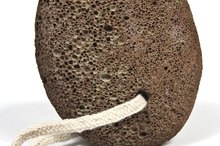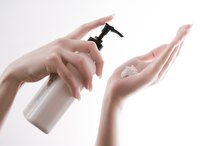What Can I Do for the Cracked Soles of My Feet?
While dry skin can seem rather innocuous, cracked soles of the feet can often itch, burn and even bleed, making you vulnerable to infection. Fortunately, medical experts have several recommendations for treating dry and cracked soles of the feet, particularly the areas most prone to cracking, the heels and the areas between the toes. In addition, you can take preventative measures at home to ensure that dry skin does not develop deep cracks.
Identification
Cracked soles of the feet can be symptomatic of various conditions, some mild and others more serious, according to the New Zealand Dermatological Society 2. Simply wearing open-heeled shoes, exercising frequently, walking barefoot or placing excess pressure on your feet can result in developing corns and calluses that ultimately create cracked foot skin. If you are prone to dry skin, your soles can develop cracks. Cracked soles may indicate medical problems such as atopic dermatitis, hypothyroidism, juvenile plantar dermatosis, psoriasis or palmoplantar keratoderma. Foot problems can also complicate conditions for people with diabetes.
- Cracked soles of the feet can be symptomatic of various conditions, some mild and others more serious, according to the New Zealand Dermatological Society 2.
- If you are prone to dry skin, your soles can develop cracks.
Prevention/Solution
Cracked Bleeding Feet
Learn More
The recommendations of the American Academy of Foot and Ankle Surgeons assert that you should lubricate dry skin before deep problems develop 1. If your symptoms are mild, try an over-the-counter cream for dry skin, or one that targets cracked heels and soles. After you shower, cover the bottoms of your feet with the moisturizer. Wear socks to keep the cream on your feet.
- The recommendations of the American Academy of Foot and Ankle Surgeons assert that you should lubricate dry skin before deep problems develop 1.
- If your symptoms are mild, try an over-the-counter cream for dry skin, or one that targets cracked heels and soles.
Expert Insight
CNN Health's guide to dry skin includes several lifestyle modifications and home remedies for treating skin conditions such as cracked soles of the feet. Begin by eliminating household items that contribute to dry skin, including harsh cleaners and drying soaps and shampoos. Instead, invest in gentle, natural cleaners and unscented toiletries formulated for sensitive or dry skin. Run a humidifier to keep the air inside your home moist. If the dry skin on your feet itches, apply a cold compress. Treat swelling and flaking skin with over-the-counter hydrocortisone ointment.
- CNN Health's guide to dry skin includes several lifestyle modifications and home remedies for treating skin conditions such as cracked soles of the feet.
Features
Salicylic Acid & Heel Cracks
Learn More
Look for key ingredients in your moisturizer that can help treat dry, cracked skin on the soles of your feet. The New Zealand Dermatological Society identifies effective ingredients that moisturize skin or gently slough off the damaged top layer such as urea, salicylic acid and alphahydroxy acid 2.
Warning
While dry skin and cracked heels may prove more of an aesthetic problem than a medical one, seriously cracked or bleeding skin may demand more drastic measures. Consult your doctor or a specialist regarding cracked or dry skin on the soles of your feet that does not respond to self-treatment, or that causes you pain. You should also speak with a doctor if you exhibit other symptoms of skin problems or diabetes.
Related Articles
References
- American College of Foot and Ankle Surgeons: Cracked Heels
- New Zealand Dermatological Society: Cracked Heels
- Institute For Preventive Foot Health. National Foot Health Assessment 2012. 2012.
- Boutrand LB, Thépot A, Muther C, et al. Repeated short climatic change affects the epidermal differentiation program and leads to matrix remodeling in a human organotypic skin model. Clin Cosmet Investig Dermatol. 2017;10:43-50. doi:10.2147/CCID.S120800
- Kapur S, Watson W, Carr S. Atopic dermatitis. Allergy Asthma Clin Immunol. 2018;14(Suppl 2):52. doi:10.1186/s13223-018-0281-6
- Safer JD. Thyroid hormone action on skin. Dermatoendocrinol. 2011;3(3):211-215. doi:10.4161/derm.3.3.17027
- Hashizume H. Skin aging and dry skin. J Dermatol. 2004;31(8):603-609. doi:10.1111/j.1346-8138.2004.tb00565.x
- Parker J, Scharfbillig R, Jones S. Moisturisers for the treatment of foot xerosis: a systematic review. J Foot Ankle Res. 2017;10:9. doi:10.1186/s13047-017-0190-9
- Linus Pauling Institute. (2012-2016). Oregon State University: Micronutrient Information Center: Essential Fatty Acids and Skin Health.
Writer Bio
Nina Makofsky has been a professional writer for more than 20 years. She specializes in art, pop culture, education, travel and theater. She currently serves as a Mexican correspondent for "Aishti Magazine," covering everything from folk art to urban trends. She holds a Bachelor of Arts in English from Mills College.








